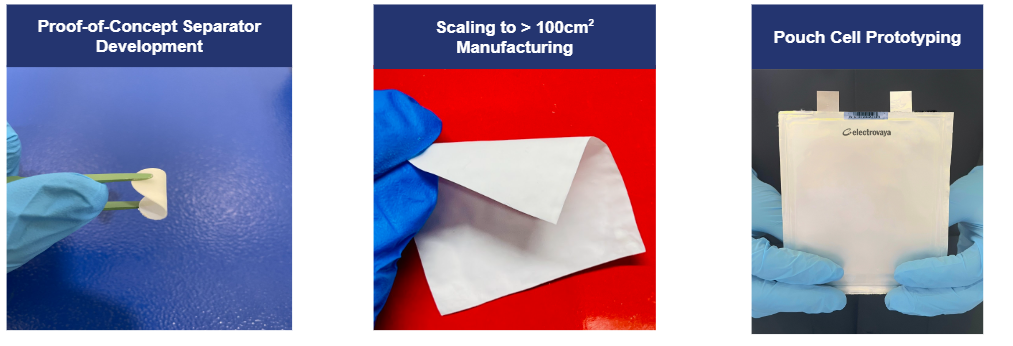Electrovaya Announces Update to Its Solid-State Battery Development
Electrovaya announced advancements in its solid-state battery development at its annual Battery Technology Day event. Key updates include the creation of a scalable lithium-ion conducting ceramic with ionic conductivity of ~8.10-4 S/cm, and the development of an improved separator membrane using this ceramic. The company has also made strides in developing stable cycling pouch cells and plans to ship prototypes to a major automaker by the end of the year. CEO Dr. Raj DasGupta expressed optimism about the commercial viability of these batteries, citing significant progress since early 2023.
- Development of a scalable and cost-effective lithium-ion conducting ceramic.
- Achieved ionic conductivity of ~8.10-4 S/cm in the ceramic material.
- Progress in developing a proprietary separator using in-house ceramics.
- Advancement in stable cycling performance for pouch cells.
- Plans to ship prototypes to a major automaker later this year.
- CEO expressed optimism about the commercial viability of the solid-state battery product.
- No specific timeline for commercial production beyond prototype shipment.
- No detailed financial data or projections provided.
- Potential risks in scaling up the production of new materials and technologies.
Insights
Electrovaya's progress in developing a scalable and cost-effective lithium-ion conducting ceramic is notable for several reasons. The ionic conductivity of ~8.10-4 S/cm is a positive indicator of the material's potential in solid-state batteries. Solid-state batteries are considered the next-big-thing in the battery industry due to their higher energy density and improved safety compared to traditional lithium-ion batteries.
The development of an improved separator membrane that utilizes this ceramic further strengthens the company's position. This separator is important because it allows for better ion flow within the battery, enhancing performance and longevity. However, scaling up production will be a significant challenge, both technically and financially. Investors should be cautious about the timeline and capital expenditure required for scaling up manufacturing to meet commercial viability.
Electrovaya's plan to ship prototypes to a major automaker later this year is promising, as it could lead to lucrative partnerships and increased revenue streams. However, actual commercialization and widespread adoption will depend on successful field tests and customer validation.
From a market perspective, Electrovaya’s advancements in solid-state battery technology align well with growing industry trends. The automotive sector is aggressively seeking solid-state batteries due to their potential for higher energy density, faster charging times and enhanced safety features. These attributes are critical for electric vehicles (EVs), which continue to gain market share globally.
The announcement of discussions with a major automaker could serve as a preliminary validation of Electrovaya's technology. If successful, such partnerships often lead to long-term supply agreements which can substantially boost revenue and market position. Investors should monitor these discussions closely, as they will be key indicators of the company's future prospects.
However, it's important to note the competitive landscape. Many companies, including established giants like Toyota and startups like QuantumScape, are also racing to commercialize solid-state batteries. Electrovaya needs to demonstrate not only technical superiority but also cost-effectiveness to secure a competitive edge.
Development of a Lithium Ion Conducting Ceramic with leading performance;
Development of an improved separator membrane that utilizes the in-house ceramics;
Plan to start shipping prototypes to a major automaker this calendar year
TORONTO, ON / ACCESSWIRE / June 13, 2024 / Electrovaya Inc. ("Electrovaya" or the "Company") (NASDAQ:ELVA)(TSX:ELVA), a leading lithium-ion battery technology and manufacturing company, today announced an update on its solid-state battery program at its annual Battery Technology Day event.

Updates regarding Electrovaya's solid state battery program included the following:
Development of a scalable and cost-effective lithium ion conducting ceramic that has demonstrated good performance: ionic conductivity in the range of ~8.10-4 S/cm; and work continues to further improve conductivity and scale up of production.
Development of a proprietary separator that uses Electrovaya's in-house ion conducting ceramic material. The separator incorporates a scalable manufacturing process and the Company has made progress in increasing the separator size to meet the needs of commercially viable cells.
Progress in the development of pouch cells with stable cycling performance.

Scaling Electrovaya's ion conducting ceramic separator to meet the needs of commercially viable cells.
"Since early 2023, our team at Electrovaya Labs has made significant progress in the development of our solid-state battery separator and ion conducting ceramic materials. These materials form the backbone of our solid-state battery design and based on the progress to date, we are optimistic on a commercially viable solid state battery product." said Dr. Raj DasGupta, CEO at Electrovaya. "We are in discussions with one major automaker and are planning to send prototype samples of pouch cells later this calendar year."
For more information, please contact:
Jason Roy
VP, Corporate Development and Investor Relations
Electrovaya Inc.
905-855-4618
jroy@electrovaya.com
About Electrovaya Inc.
Electrovaya Inc. (NASDAQ:ELVA)(TSX:ELVA) is a pioneering leader in the global energy transformation, focused on contributing to the prevention of climate change by supplying safe and long-lasting lithium-ion batteries. The Company has extensive IP and designs, develops and manufactures proprietary lithium-ion batteries and battery systems for energy storage and heavy duty electric vehicles based on its Infinity Battery Technology Platform. This technology offers enhanced safety and industry leading battery longevity. The Company is also developing next generation solid state battery technology at its Labs division. Headquartered in Ontario, Canada, Electrovaya has two operating sites in Canada and has acquired a 52-acre site with a 135,000 square foot manufacturing facility in New York state for its planned gigafactory. To learn more about Electrovaya, please explore www.electrovaya.com.
Forward-Looking Statements
This press release contains forward-looking statements relating to announcements regarding cell performance, cycle life, longevity, projected performance, extrapolated cycle life, relative performance compared to competitors, planned production in Jamestown New York, planned commercialization of solid state batteries, performance of solid state batteries, performance of separator membranes, performance of ion conducting ceramic materials, viability of manufacturing scale up, ability to sample prototype solid state battery cells in calendar year 2024, use in commercial vehicle applications, energy density, cell performance, safety, cost of ownership, life cycle cost, and can generally be identified by the use of words such as "may", "will", "could", "should", "would", "likely", "possible", "expect", "intend", "estimate", "anticipate", "believe", "plan", "objective", "seed", "growing" and "continue" (or the negative thereof) and words and expressions of similar import. Although the Company believes that the expectations reflected in such forward-looking statements are reasonable, such statements involve risks and uncertainties, and undue reliance should not be placed on such statements. Certain material factors and assumptions are applied in making forward-looking statements, and actual results may differ materially from those expressed or implied in such statements. Statements with respect to solid state batteries, battery technologies and production roadmaps, are based on an assumption that the Company's customers and users will deploy its products in accordance with communicated intentions, and the Company has investment capital to deploy. Important factors that could cause actual results to differ materially from expectations include but are not limited to macroeconomic effects on the Company and its business and on the Company's customers, including inflation and tightening credit availability due to systemic bank risk, economic conditions generally and their effect on consumer demand and capital availability, labour shortages, supply chain constraints, the potential effect of health based restrictions in Canada, the US and internationally on the Company's ability to produce and deliver products, and on its customers' and end users' demand for and use of products, which effects are not predictable and may be affected by additional regional outbreaks and variants, and other factors which may cause disruptions in the Company's supply chain and Company's capability to deliver and develop its products. Additional information about material factors that could cause actual results to differ materially from expectations and about material factors or assumptions applied in making forward-looking statements may be found in the Company's Annual Information Form for the year ended September 30, 2023 under "Risk Factors", and in the Company's most recent annual Management's Discussion and Analysis under "Qualitative And Quantitative Disclosures about Risk and Uncertainties" as well as in other public disclosure documents filed with Canadian securities regulatory authorities. The Company does not undertake any obligation to update publicly or to revise any of the forward-looking statements contained in this document, whether as a result of new information, future events or otherwise, except as required by law.
SOURCE: Electrovaya, Inc.
View the original press release on accesswire.com







